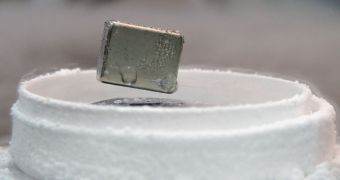Superconductivity was discovered at the beginning of the 20th century, when scientists started experimenting with mercury cooled down to temperatures only 4 degrees above absolute zero. They observed that, during the transition to a superconducting state, materials started to experience electrical resistance close to zero, meaning that current was flowing through the superconductive substance without power loss.
However, it seemed that superconductivity was experienced only at temperatures close to absolute zero. They explained the superconductivity phenomenon as being the result of electron pairing inside the material in order to travel through the conductor without being scattered by the atoms. But there is a problem. Electrostatic forces produced by the charge of the electrons shouldn't allow such processes to take place. "It appears that the electrons with the strongest repulsion in one situation are the most adept at superconductivity in another. It's counterintuitive, but that's what's happening," said professor of physics at Princeton University, Ali Yazdani.
Two decades ago, researchers discovered high-temperature semiconductors, substances that experience zero electrical resistance at temperatures as high as 150 Kelvin. This enabled them to get rid of the expensive helium and to use nitrogen for getting substances at superconducting temperatures. But the mechanism of superconductivity transition was nothing similar to that of low-temperature superconductors, electrons did not bond in these materials.
Instead, say Princeton researchers, high-temperatures superconductors are able to make use of their repulsive forces. They showed that, when materials are heated, the electrons lose their capability to bond and start to exhibit unique quantum properties, meaning that they are exerting extremely powerful electrostatic repulsive forces between each other.
Surprisingly, high-temperature superconductive materials are most likely to form bonds effortlessly by exerting repulsion forces, the same experienced as the material shifts to a non-superconductive state. "What we have found is that the traditional signatures of what some might call the 'glue' are there - we can measure them with high accuracy on the atomic scale. They don't control the formation of the superconducting pairs, though. They are more like spectators," concluded Yazdani.

 14 DAY TRIAL //
14 DAY TRIAL //